|
 Lactarius sepiaceus Lactarius sepiaceus
BiostatusPresent in region - Indigenous. Endemic
Images (click to enlarge)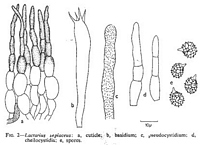 | 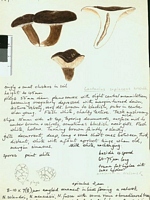
Caption: Watercolour
Owner: G.M. Taylor | 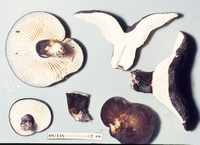
Caption: ZT69-116
Owner: E. Horak: © Creative Commons Attribution-Noncommercial 3.0 New Zealand | 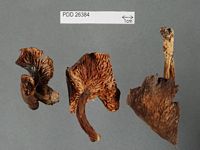
Caption: Dried type specimen
Owner: Herb PDD | 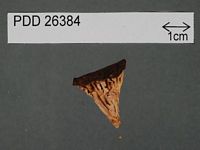
Caption: Dried type specimen
Owner: Herb PDD |
Article: McNabb, R.F.R. (1971). The Russulaceae of New Zealand. 1. Lactarius DC ex S.F. Gray. New Zealand Journal of Botany 9(1): 46-66 (http://www.rsnz.org/publish/abstracts.php).
Description: pileus: 5- 12 cm diam., convex when young, centrally depressed to shallow-infundibuliform at maturity, dry, pruinose to subvelutinate under lens, azonate, rugulose or irregularly folded particularly near margins when young, conspicuously so when mature, dark greyish brown, sepia, or dark brownish black, often with glaucous patches; margins involute at maturity, entire, often undulate. Cuticle composed of erect, thin-walled, hyaline, septate, simple, ± filamentous elements to 80 µm long, 3-10 µm diam., with dark brown contents in KOH, originating from inflated, short-celled hyphae. lamellae: subdecurrent to decurrent, moderately crowded to subdistant, thick, simple, to 6 mm deep, pallid creamy white to pallid cream, typically with dark brown edges; lamellulae present in 2-3 unequal series; latex viscid, white to pallid creamy white, unchanging on exposure to air, drying pallid cream. stipe: 2-6 cm long, ± equal, 1-2.5 cm diam. stout, chambered to hollow at maturity, dry, pruinose to subvelutinate under lens, concolorous with pileus; flesh sordid white, unchanging. Cuticle similar to that of pileus. spores: spore print white; spores broadly elliptical to ovate-elliptical, obliquely and prominently apiculate, apiculus to 2.5-(3) µm long, 7.5-11 X 6.5-9.5 µm, ornamentation of fine to moderately coarse amyloid ridges to 1.2,µm high forming a complete or almost complete reticulum; plage weakly amyloid, indistinct. hymenium: basidia hyaline, subclavate to clavate, 55-80 X 7.5-10.5 µm, 4-spored, sterigmata to 11 µm long; pleurocystidia not seen; cheilocystidia numerous, filamentous, hyaline, thin-walled, septate, 30-65 X 4.5-7 µm; pseudocystidia sparse, scattered, originating from lactiferous hyphae, irregularly cylindrical, not or only slightly projecting beyond basidia, to 6 µm diam. hymenophoral trama: heteromerous, composed of lactiferous hyphae, rather loosely interwoven, short-celled connective hyphae, and sphaerocysts in the proximal half; subhymenium of closely interwoven connective hyphae, appearing cellular in section. context of pileus: white with very faint salmon pink tints on prolonged exposure to air, thick, firm, rather coarsely granular. smell: not distinctive. taste: lamellae and context mild. chemical characters: formalin - n.r.: phenol - slowly deep vinaceous; FeSO4 - rapidly salmon pink; guaiacol - salmon pink darkening to brick red; KOH on pileus - slight darkening; on context - faint yellow; NH4OH on pileus and context - n.r.
Habitat: Solitary or gregarious under Nothofagus
Notes: cuticular structure, and white latex indicate that this species belongs in sect. Plinthogali subsect. Fuliginosi as defined by Singer (1962), although Singer indicated that he was reluctant to include species with white spores in this section. In a monograph of the North American species of sect. Plinthogali, Smith and Hesler (1962) considerably expanded Singer's concept by the inclusion of species with white spores.
Lactarius sepiaceus is characterised by the dark brown pruinose to subvelutinate pileus and stipe, cream lamellae, and prominently apiculate spores with reticulate ornamentation.
|